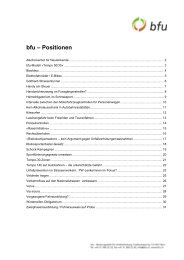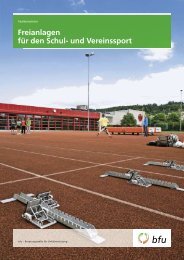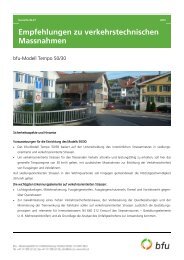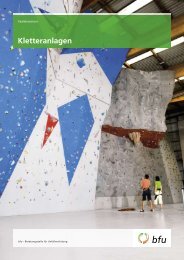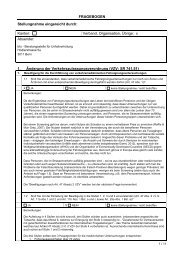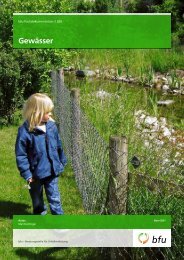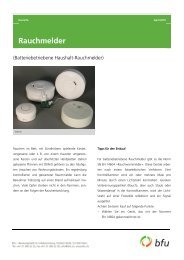Haus und Freizeit - bfu
Haus und Freizeit - bfu
Haus und Freizeit - bfu
Sie wollen auch ein ePaper? Erhöhen Sie die Reichweite Ihrer Titel.
YUMPU macht aus Druck-PDFs automatisch weboptimierte ePaper, die Google liebt.
isk group. Besides their age-related awareness of<br />
an appropriate risk awareness, educational intervention<br />
forms are also recommended prevention<br />
methods for supervisors (Table 11).<br />
Locking away and storing toxic substances and<br />
medicaments securely are also considered advisable.<br />
WHO is also calling for the development and<br />
implementation of laws/standards for the production,<br />
storage, distribution and disposal of potential<br />
toxic substances.<br />
4.4.7 «Electrocution» accident segment<br />
Table 11<br />
Prevention options recommended for accidents for the accident<br />
segment «Poisoning and chemical burns»<br />
Risk factor Prevention option Poisoning Chemical<br />
burn<br />
Children and adolescents<br />
Victim’s lack of or<br />
limited awareness<br />
of danger<br />
Supervisor’s low<br />
awareness of<br />
danger<br />
Development: fun<br />
experimenting/urge<br />
to explore<br />
Toxic household<br />
products<br />
Current use of toxic<br />
substances in the<br />
household<br />
Lack of provisions<br />
and standards for<br />
toxic products and<br />
their packaging<br />
Storage/safekeeping<br />
of toxic or potentially<br />
harmful<br />
household products<br />
Poor perception and<br />
a lack of <strong>und</strong>erstanding<br />
for signs<br />
of danger<br />
Age-dependent awareness<br />
raising of awareness<br />
of danger<br />
Supervisor must accept<br />
age-dependent responsibility<br />
for prevention<br />
Raising supervisor’s<br />
awareness for a marked<br />
awareness of danger<br />
As the educator, make<br />
sure that children<br />
cannot access anything<br />
toxic when exploring<br />
their environment<br />
Removal of toxic<br />
products from the<br />
household<br />
Parental education on<br />
safe behaviour and<br />
improved child supervision<br />
Legislation and/or<br />
guidelines for childproof<br />
packaging including<br />
child closure systems<br />
Storage of toxic or<br />
potentially harmful<br />
household products in<br />
lockable cupboard<br />
Availability/recording of<br />
toxicology centre’s<br />
emergency number<br />
(145)<br />
Only pack medicaments<br />
in non-lethal doses<br />
All age segments<br />
Users are called upon to<br />
look actively for S<br />
(safety) and R (risk)<br />
phrases<br />
Users should look<br />
actively for symbols of<br />
danger<br />
x<br />
x<br />
x<br />
x<br />
x<br />
x<br />
x<br />
x<br />
x<br />
x<br />
x<br />
x<br />
x<br />
x<br />
x<br />
x<br />
x<br />
x<br />
x –<br />
x<br />
x<br />
x<br />
x<br />
The terms «electrical accident», «power accident»<br />
and «electric shock» are mainly used synonymously<br />
in the literature, whereby these terms denote injuries<br />
caused by electricity. The children and adolescents<br />
age group is identified here as a risk group.<br />
While there is little evidence-based knowledge<br />
both in terms of the cause of the accident and in<br />
terms of successful prevention measures, the epidemiological<br />
data show that the «Electrocution»<br />
accident segment generates the lowest incidence<br />
of injuries in the home and leisure sector when<br />
compared with the other accident segments. It is<br />
possible that the current safety standard and/or<br />
awareness of prevention correspond to a high<br />
Table 12<br />
Prevention options recommended for accidents caused by<br />
electricity<br />
Risk factor<br />
Prevention option<br />
Children and adolescents<br />
Victim’s lack of or limited Age-dependent awareness raising of awareness<br />
of awareness of danger<br />
danger<br />
Supervisor’s low awareness<br />
of danger<br />
Electrical sockets, outlets<br />
Lack of attention for or<br />
knowledge of important<br />
behavioural rules when<br />
using electricity<br />
Handling and/or using<br />
electronic equipment in<br />
damp/wet environments<br />
Supervisor must accept age-dependent<br />
responsibility for prevention<br />
Raising supervisor’s awareness for a marked<br />
awareness of danger<br />
Protection of power outlets and power strips<br />
with inserts/dummy plugs<br />
Installation of child protection power outlets<br />
Include the installation of residual current<br />
circuit breakers in electrical installations<br />
All age segments<br />
Awareness-raising and clarification on the<br />
safe use of electricity<br />
Adaptation of domestic equipment and/or<br />
setting<br />
«Design for safety» Þ establish passive safety<br />
mechanisms<br />
Radiant heaters and other electrical appliances<br />
should be permanently installed in<br />
bathrooms at a safe distance of at least one<br />
metre from the bath<br />
Clear away electrical equipment after use to<br />
prevent children from playing with it<br />
Installation of a residual current circuit<br />
breaker<br />
82 Kurzfassung / Version abrégée / Riassunto / Condensed Version <strong>bfu</strong>-Sicherheitsdossier Nr. 09



